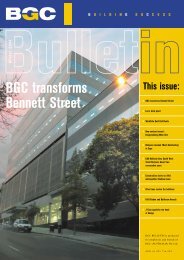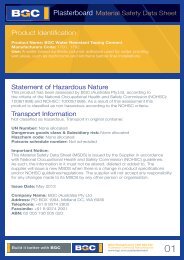Plasterboard & Cornice - BGC
Plasterboard & Cornice - BGC
Plasterboard & Cornice - BGC
Create successful ePaper yourself
Turn your PDF publications into a flip-book with our unique Google optimized e-Paper software.
08<br />
Wall Framing<br />
Screws will be bugle head and comply with AS2455 and be compatible with the substrate. Screws shall be driven slightly<br />
below the surface without punching through the face liner paper.<br />
Minimum Screw Fastener Length - Table 6<br />
THICKNESS<br />
(mm)<br />
10<br />
13<br />
16<br />
1. Screws used for fixing plasterboard to timber ceiling substrates (hardwood and softwood) shall have a minimum length of<br />
30mm and be Type W.<br />
2. S point screws shall be used for steel thickness less than or equal to 0.75mm base material thickness (BMT)<br />
3. Drill point screws shall be used for steel thick ness greather than 0.75mm base material thickness (BMT)<br />
Note: When fixing into preservative treated timbers, Class A AS 3566 coatings of screws and nails are to be used.<br />
Fixing to Framing<br />
Walls<br />
25 needle point<br />
(see note 1)<br />
25 needle point<br />
(see note 1)<br />
30 needle point<br />
(see note 1)<br />
Daubs of <strong>BGC</strong> Stud Adhesive, 25mm diameter x 15mm<br />
high are positioned in the pattern as shown in Table 4,<br />
spaced at a maximum of 300mm and a minimum of 200mm.<br />
<strong>BGC</strong> Stud Adhesive must not be used at wall-to-wall and<br />
wall-to-ceiling junctions, around openings, butt joints or<br />
fastener points.<br />
<strong>BGC</strong> <strong>Plasterboard</strong> is placed horizontally along each wall.<br />
Sheets to be packed 6-10mm from floor and fastened<br />
along the top recessed edge at each stud or<br />
furring channel.<br />
Timber Frame Application<br />
<strong>BGC</strong> PLASTERBOARD & CORNICE - November - 2012<br />
SUBSTRATE MATERIAL<br />
HARDWOOD<br />
SOFTWOOD STEEL<br />
SCREW LENGTH mm SCREW GUAGE NO. SCREW LENGTH mm SCREW GUAGE NO. SCREW LENGTH mm SCREW GUAGE NO.<br />
6<br />
6<br />
6<br />
25 needle point<br />
(see note 1)<br />
30 needle point<br />
(see note 1)<br />
45 needle point<br />
300 mm typical<br />
fixing centres<br />
6<br />
6<br />
6<br />
25 needle point<br />
(see note 2&3)<br />
25 needle point<br />
(see note 2&3)<br />
30 needle point<br />
(see note 2&3)<br />
The sheets are then pressed firmly against the studs<br />
and temporary fastened midway across the sheet<br />
at every second stud or furring channel.<br />
Next, fasten the other recessed edge at each stud,<br />
or furring channel.<br />
Fasteners must not coincide with <strong>BGC</strong> Stud Adhesive<br />
daubs, and fasteners should be kept to a minimum distance<br />
of 200mm from adhesive daubs.<br />
Fasteners around openings should be placed at a maximum<br />
spacing of 300mm centres. Allow at least 24 hours for the<br />
adhesive to set.<br />
300 mm<br />
typical<br />
fixing centres<br />
Secure sheet edges<br />
by nailing at each stud<br />
<strong>BGC</strong> Stud Adhesive<br />
daubs 210mm typical<br />
from sheet edge Set sheets 6-10 mm clear of floor<br />
<strong>BGC</strong> Stud<br />
Adhesive<br />
daubs<br />
200-300mm<br />
typical<br />
centres<br />
6<br />
6<br />
6















